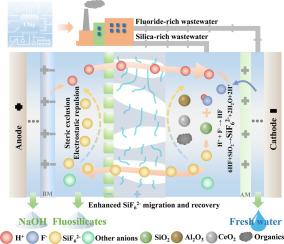当前位置:
X-MOL 学术
›
Water Res.
›
论文详情
Our official English website, www.x-mol.net, welcomes your
feedback! (Note: you will need to create a separate account there.)
Dual-ion permeation Janus membrane-assisted element reconstitution system enables fluorosilicate-oriented recovery from fluoride-rich and silica-rich wastewaters
Water Research ( IF 11.4 ) Pub Date : 2024-11-12 , DOI: 10.1016/j.watres.2024.122785 Yangbo Qiu, Chao Wang, Ran Li, Lidong Feng, Shuaijun Yu, Jiangnan Shen, Long-Fei Ren, Jiahui Shao
Water Research ( IF 11.4 ) Pub Date : 2024-11-12 , DOI: 10.1016/j.watres.2024.122785 Yangbo Qiu, Chao Wang, Ran Li, Lidong Feng, Shuaijun Yu, Jiangnan Shen, Long-Fei Ren, Jiahui Shao

|
Rapid development of semiconductor manufacturing and photovoltaic industry leads to significant generation of fluoride-rich and silica-rich wastewaters. Due to the emphasis on circular economy and resource recovery, there is a shift from regarding wastewater as waste to a recoverable resource. In this study, we present a uniquely designed dual-ion permeation Janus membrane (DPM)-assisted element reconstitution system (MERS) for selective recovery of high-value fluorosilicates from fluoride-rich and silica-rich wastewaters. The MERS with a configuration of cation-exchange membrane/bipolar membrane/DPM/anion-exchange membrane/cation-exchange membrane achieved HF formation in silica chamber and further SiF6 2- generation from the reaction of HF with SiO2 . Driven by the electric field, SiF6 2- was then transported through DPM into acid chamber for fluorosilicates selective recovery. The DPM with positively-charged nanoporous substrate/negatively charged active layer enhanced electrostatic interaction for SiF6 2- /H+ transport and steric exclusion for coexisting foulants rejection. Ion transport mechanism analysis demonstrated DPM enhanced SiF6 2- migration while inhibiting back diffusion by electrostatic interaction and steric exclusion. Through the application of DPM, MERS showed rejections over 99 % for nanoparticles and over 90 % for organics. Thus, MERS stably selectively recovered SiF6 2- with recovery rate over 85 % and fluorosilicates purity over 99.5 %. Compared to traditional technologies, MERS achieved valuable resource recovery with the advantages of simple operation, small footprint and no secondary pollutant generation. Overall, this study provides a new strategy for simultaneous recovery of fluoride and silica from different waste streams, enabling a more sustainable strategy for semiconductor and photovoltaic industries development.
中文翻译:

双离子渗透 Janus 膜辅助元件重构系统可从富含氟化物和富含二氧化硅的废水中进行氟硅酸盐定向回收
半导体制造和光伏行业的快速发展导致大量富含氟化物和富含二氧化硅的废水的产生。由于对循环经济和资源回收的重视,人们从将废水视为废物转变为可回收资源。在这项研究中,我们提出了一种独特设计的双离子渗透 Janus 膜 (DPM) 辅助元素重构系统 (MERS),用于从富含氟化物和富含二氧化硅的废水中选择性回收高价值的氟硅酸盐。具有阳离子交换膜/双极膜/DPM/阴离子交换膜/阳离子交换膜配置的 MERS 在二氧化硅室中实现了 HF 的形成,并进一步从 HF 与 SiO2 的反应中生成了 SiF62-。在电场的驱动下,SiF62- 然后通过 DPM 输送到酸室中,用于氟硅酸盐的选择性回收。具有带正电荷的纳米多孔衬底/带负电荷的活性层的 DPM 增强了 SiF62-/H+ 传输的静电相互作用和共存污垢去除的空间排斥。离子传输机制分析表明,DPM 增强了 SiF62 迁移,同时通过静电相互作用和空间排斥抑制了反向扩散。通过应用 DPM,MERS 对纳米颗粒的截留率超过 99%,对有机物的截留率超过 90%。因此,MERS 稳定地选择性回收了 SiF62-,回收率超过 85%,氟硅酸盐纯度超过 99.5%。与传统技术相比,MERS 实现了宝贵的资源回收,具有操作简单、占地面积小、无需二次产生污染物等优点。 总体而言,本研究为从不同的废物流中同时回收氟化物和二氧化硅提供了一种新策略,为半导体和光伏行业的发展提供了更可持续的战略。
更新日期:2024-11-12
中文翻译:

双离子渗透 Janus 膜辅助元件重构系统可从富含氟化物和富含二氧化硅的废水中进行氟硅酸盐定向回收
半导体制造和光伏行业的快速发展导致大量富含氟化物和富含二氧化硅的废水的产生。由于对循环经济和资源回收的重视,人们从将废水视为废物转变为可回收资源。在这项研究中,我们提出了一种独特设计的双离子渗透 Janus 膜 (DPM) 辅助元素重构系统 (MERS),用于从富含氟化物和富含二氧化硅的废水中选择性回收高价值的氟硅酸盐。具有阳离子交换膜/双极膜/DPM/阴离子交换膜/阳离子交换膜配置的 MERS 在二氧化硅室中实现了 HF 的形成,并进一步从 HF 与 SiO2 的反应中生成了 SiF62-。在电场的驱动下,SiF62- 然后通过 DPM 输送到酸室中,用于氟硅酸盐的选择性回收。具有带正电荷的纳米多孔衬底/带负电荷的活性层的 DPM 增强了 SiF62-/H+ 传输的静电相互作用和共存污垢去除的空间排斥。离子传输机制分析表明,DPM 增强了 SiF62 迁移,同时通过静电相互作用和空间排斥抑制了反向扩散。通过应用 DPM,MERS 对纳米颗粒的截留率超过 99%,对有机物的截留率超过 90%。因此,MERS 稳定地选择性回收了 SiF62-,回收率超过 85%,氟硅酸盐纯度超过 99.5%。与传统技术相比,MERS 实现了宝贵的资源回收,具有操作简单、占地面积小、无需二次产生污染物等优点。 总体而言,本研究为从不同的废物流中同时回收氟化物和二氧化硅提供了一种新策略,为半导体和光伏行业的发展提供了更可持续的战略。

































 京公网安备 11010802027423号
京公网安备 11010802027423号